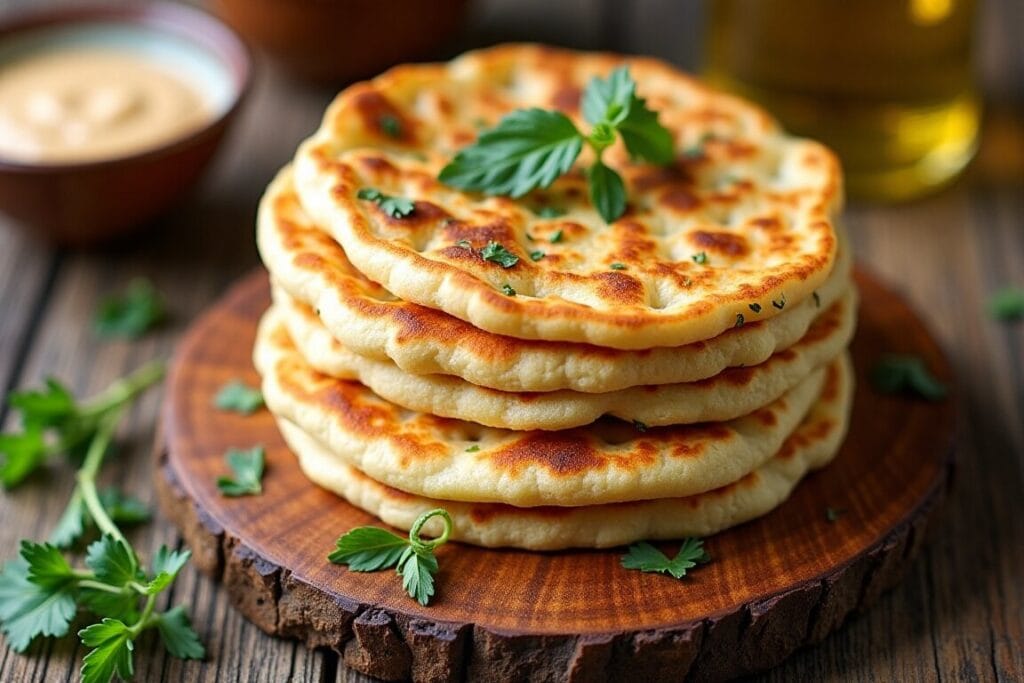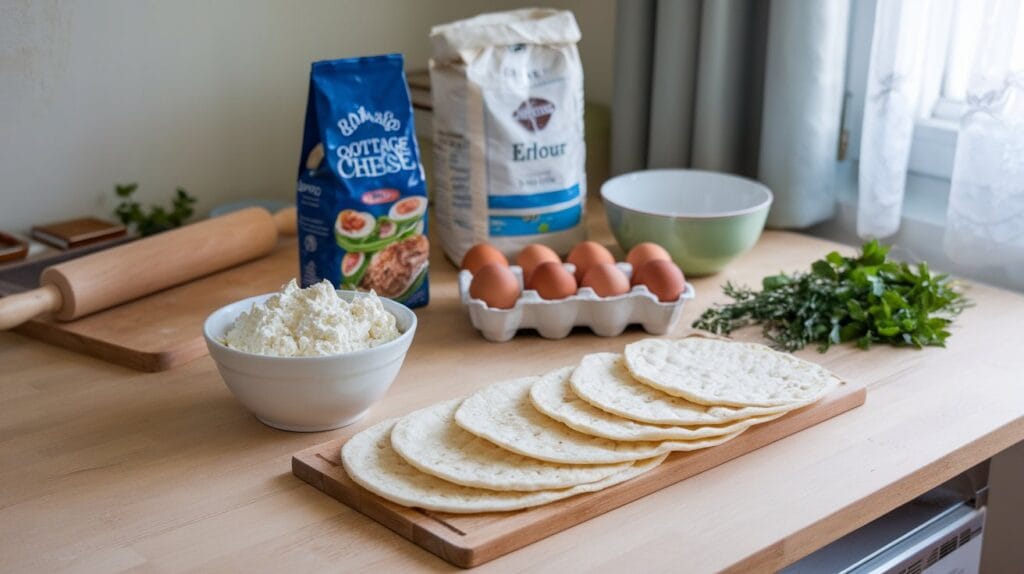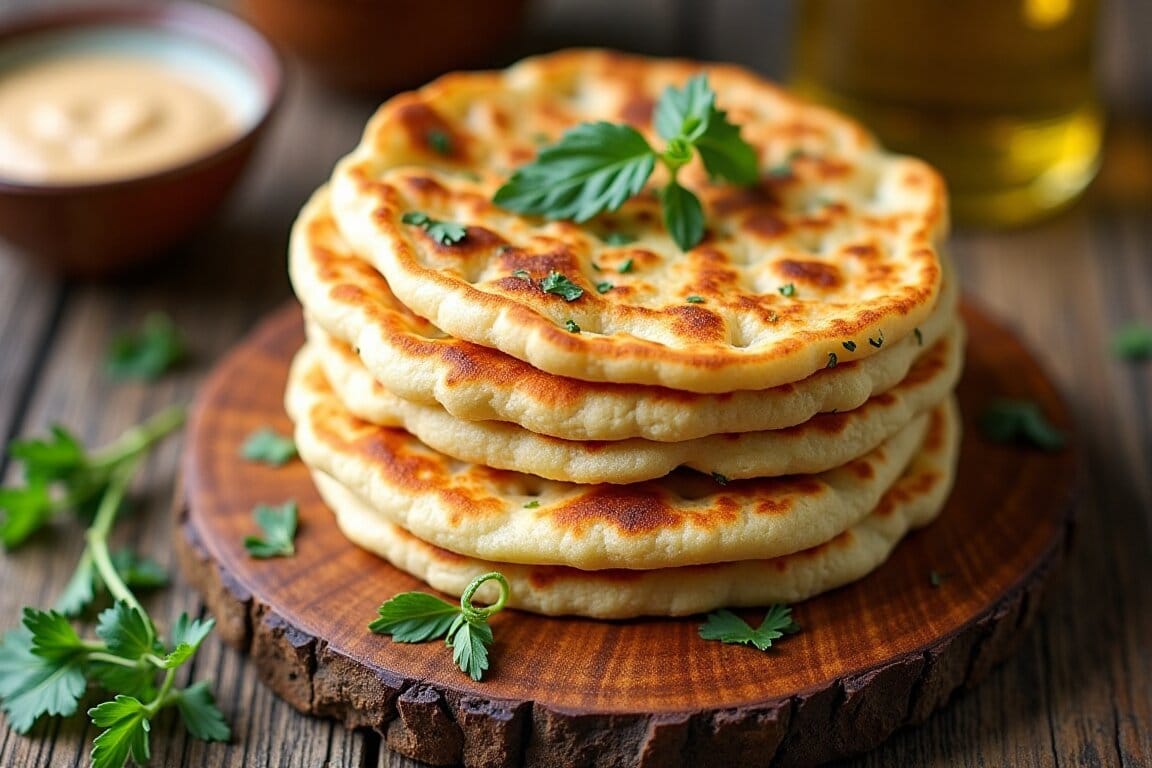Introduction
Flatbreads have long been a staple in cuisines around the world, celebrated for their versatility and simplicity. Adding cottage cheese to flatbread brings an exciting twist, enhancing both the texture and nutritional value. Cottage cheese flatbread is not just a delicious option; it’s also packed with protein, making it an excellent choice for those looking to maintain a healthy lifestyle without compromising on taste.
This guide dives into everything you need to know about making cottage cheese flatbread, from the essential ingredients and step-by-step preparation to creative variations and serving suggestions. Whether you’re a seasoned cook or a kitchen novice, this recipe promises to be a delightful addition to your culinary repertoire.

What is Cottage Cheese Flatbread?
Cottage cheese flatbread is a soft, thin bread made with a base of cottage cheese and a mix of other simple ingredients like flour, eggs, and spices. The cottage cheese lends a creamy texture and subtle tangy flavor that sets it apart from traditional flatbreads. Ideal for a quick snack or as a base for pizzas, wraps, or even dessert, this bread is as versatile as it is tasty.
Benefits of Cottage Cheese in Recipes
Cottage cheese is often hailed as a superfood due to its impressive nutritional profile. It’s high in protein and low in fat, making it a favorite among fitness enthusiasts. Additionally, its creamy consistency adds moisture and a rich flavor to recipes without the need for heavy cream or butter. For flatbreads, cottage cheese works as a natural binder, helping to create a soft and pliable texture that’s easy to work with.
Why Flatbread is a Perfect Base
Flatbread is a culinary blank canvas. Its simplicity allows you to experiment with different flavors and toppings, from savory to sweet. Incorporating cottage cheese into the dough elevates the basic flatbread, turning it into something nutritious and satisfying. Whether you prefer a quick breakfast, a lunch wrap, or an appetizer for dinner parties, cottage cheese flatbread fits the bill.
Ingredients Needed for Cottage Cheese Flatbread
To create the perfect cottage cheese flatbread, you’ll need a mix of basic pantry staples and a handful of fresh ingredients to bring the recipe to life. In this section, we’ll break down the essential components and explain why each one is critical for the recipe’s success. Additionally, we’ll cover optional add-ons that can boost flavor and texture, allowing you to customize the flatbread to your liking. With these ingredients in hand, you’ll be well-prepared to make a flatbread that’s not only delicious but also adaptable to various tastes.

Basic Ingredients
Here’s a list of the core ingredients required to make cottage cheese flatbread:
- Cottage Cheese (1 cup): The star of the recipe, providing a creamy texture and protein. Opt for full-fat or low-fat varieties based on your dietary preferences.
- All-Purpose Flour (1½ cups): Acts as the main structure of the dough. For a healthier twist, you can use whole wheat or gluten-free flour.
- Egg (1 large): Helps bind the ingredients together and adds richness.
- Baking Powder (1 teaspoon): A leavening agent that ensures the flatbread stays light and fluffy.
- Salt (½ teaspoon): Enhances the flavor of the dough.
- Olive Oil (1 tablespoon): Adds moisture and a subtle richness to the dough.
Optional Add-Ons for Flavor
For those who love experimenting with flavors, consider these optional additions:
- Herbs and Spices: Fresh dill, parsley, garlic powder, or paprika can complement the tangy taste of cottage cheese.
- Seeds: Add sesame, flaxseeds, or chia seeds for a crunchy texture and nutritional boost.
- Grated Cheese: A small amount of Parmesan or cheddar can enhance the flavor if you’re not strictly counting calories.
Choosing the Best Cottage Cheese
The type of cottage cheese you use can make or break your flatbread. Here’s what to look for:
- Texture: Smooth cottage cheese works best, but if you have a chunky version, blend it lightly before use.
- Fat Content: Full-fat cottage cheese delivers a richer taste, while low-fat varieties keep it lighter. Choose according to your dietary goals.
- Freshness: Always use fresh cottage cheese for optimal flavor and consistency. Check the expiration date and store it properly in the fridge.
With your ingredients prepped, you’re ready to move on to the fun part: making the flatbread! Let me know if you’re ready for the next section, where we’ll explore the step-by-step preparation process.
Ingredients Needed for Cottage Cheese Flatbread
To create the perfect cottage cheese flatbread, you’ll need a combination of basic pantry staples and a few fresh ingredients. Not only does each ingredient play a vital role in the recipe’s success, but they also contribute to the unique texture and flavor of the flatbread. Furthermore, this section highlights why each item is essential, helping you understand the science behind the recipe. Additionally, we’ll explore some optional add-ons that can elevate the flavor and make your flatbread truly special.
Basic Ingredients
Here’s a list of the core ingredients required to make cottage cheese flatbread:
- Cottage Cheese (1 cup): The star of the recipe, providing a creamy texture and protein. Opt for full-fat or low-fat varieties based on your dietary preferences.
- All-Purpose Flour (1½ cups): Acts as the main structure of the dough. For a healthier twist, you can use whole wheat or gluten-free flour.
- Egg (1 large): Helps bind the ingredients together and adds richness.
- Baking Powder (1 teaspoon): A leavening agent that ensures the flatbread stays light and fluffy.
- Salt (½ teaspoon): Enhances the flavor of the dough.
- Olive Oil (1 tablespoon): Adds moisture and a subtle richness to the dough.
Optional Add-Ons for Flavor
For those who love experimenting with flavors, consider these optional additions:
- Herbs and Spices: Fresh dill, parsley, garlic powder, or paprika can complement the tangy taste of cottage cheese.
- Seeds: Add sesame, flaxseeds, or chia seeds for a crunchy texture and nutritional boost.
- Grated Cheese: A small amount of Parmesan or cheddar can enhance the flavor if you’re not strictly counting calories.
Choosing the Best Cottage Cheese
The type of cottage cheese you use can make or break your flatbread. Here’s what to look for:
- Texture: Smooth cottage cheese works best, but if you have a chunky version, blend it lightly before use.
- Fat Content: Full-fat cottage cheese delivers a richer taste, while low-fat varieties keep it lighter. Choose according to your dietary goals.
- Freshness: Always use fresh cottage cheese for optimal flavor and consistency. Check the expiration date and store it properly in the fridge.
With your ingredients prepped, you’re ready to move on to the fun part: making the flatbread!
Variations of Cottage Cheese Flatbread
One of the best aspects of cottage cheese flatbread is its remarkable adaptability. With just a few tweaks to the recipe, you can effortlessly create variations to suit almost any taste or dietary requirement. For instance, whether you prefer sweet or savory options, or even need gluten-free alternatives, there’s always a way to customize this versatile flatbread. Moreover, its ability to cater to diverse preferences ensures that it fits perfectly into any occasion, from casual snacks to gourmet meals. Here’s how you can transform your flatbread with a few creative adjustments.
Sweet and Savory Options
- Savory Variations:
- Herb-Infused Flatbread: Add a mix of fresh herbs like rosemary, thyme, or dill to the dough for an aromatic twist.
- Cheese Lovers’ Delight: Mix in shredded cheddar, mozzarella, or Parmesan for extra cheesiness.
- Spiced Flatbread: Incorporate spices like cumin, paprika, or chili flakes for a flavorful kick.
- Sweet Variations:
- Honey Cinnamon Flatbread: Add a touch of cinnamon and drizzle with honey for a sweet breakfast option.
- Fruit-Topped Delight: Pair the flatbread with fresh fruits like strawberries, blueberries, or sliced bananas, and top with a dollop of Greek yogurt.
- Nutty Flatbread: Mix in crushed nuts such as almonds or walnuts for added crunch and richness.
Gluten-Free and Vegan Alternatives
- Gluten-Free Version:
- Swap the all-purpose flour for a gluten-free flour blend or almond flour. Note that you may need to adjust the quantity of liquid to maintain the right dough consistency.
- Use a binding agent like xanthan gum if your gluten-free mix doesn’t include one.
- Vegan Version:
- Replace the cottage cheese with a plant-based alternative such as almond or cashew cream cheese.
- Substitute the egg with a flaxseed egg (1 tablespoon of ground flaxseed mixed with 2.5 tablespoons of water).
- Use coconut oil or vegan butter instead of olive oil for a richer flavor.
Regional Twists on Flatbread Recipes
- Mediterranean-Inspired Flatbread: Top with sun-dried tomatoes, olives, and feta cheese for a Mediterranean flair.
- Indian-Style Paratha: Add spices like turmeric and garam masala to the dough, and brush the cooked flatbread with ghee or butter.
- Middle Eastern Za’atar Flatbread: Sprinkle the dough with za’atar seasoning before cooking, and serve with hummus or baba ghanoush.
- Italian Focaccia-Style Flatbread: Roll the dough thicker and bake it with olive oil, rosemary, and sea salt for a focaccia-like result.
Experimenting with Shape and Size
- Use cookie cutters to make fun shapes for kids.
- Roll the dough into mini flatbreads for appetizers or party platters.
- Make extra-large flatbreads to use as wraps or sandwich bases.
With these variations, the possibilities for cottage cheese flatbread are virtually endless. From accommodating dietary restrictions to indulging in unique flavor combinations, there’s a version for everyone.Nutritional Benefits of Cottage Cheese Flatbread
Cottage cheese flatbread isn’t just a tasty treat; it’s also packed with nutritional value. By combining cottage cheese with wholesome ingredients, this flatbread offers a well-rounded profile of macronutrients and micronutrients that make it a smart choice for a variety of diets. Here’s a breakdown of its key health benefits.
High Protein and Low Fat Benefits
- Rich in Protein: Cottage cheese is an excellent source of high-quality protein, which is essential for muscle repair, immune function, and overall health. Each serving of this flatbread can provide up to 10–15 grams of protein, depending on the recipe.
- Low in Fat: Opting for low-fat or non-fat cottage cheese keeps the fat content of the flatbread minimal without compromising on flavor. For those following a low-fat diet, this is a fantastic alternative to buttery breads.
How It Fits into Popular Diets
- Low-Carb and Keto-Friendly: By using almond or coconut flour as a substitute, cottage cheese flatbread can easily fit into low-carb or ketogenic diets. The high protein and fat content of the cottage cheese provides sustained energy without spiking blood sugar.
- Weight Management: Thanks to its high protein content, cottage cheese flatbread promotes satiety, helping you feel full longer and potentially aiding in weight loss.
- Vegetarian Diets: This flatbread is naturally vegetarian and can be adapted to vegan preferences with a few substitutions.
- Mediterranean Diet: By pairing the flatbread with olive oil, fresh vegetables, and hummus, it aligns beautifully with the principles of the Mediterranean diet.
Micronutrient Boost
- Calcium: Cottage cheese is rich in calcium, supporting strong bones and teeth. Incorporating it into flatbread makes it a great option for those looking to improve their calcium intake.
- B Vitamins: The B vitamins in cottage cheese, especially riboflavin and vitamin B12, aid in energy production and nervous system health.
- Minerals: Potassium, phosphorus, and selenium from cottage cheese contribute to heart health, bone strength, and antioxidant defenses.
Comparing to Other Bread Options
- Higher Protein Content: Compared to traditional flatbreads made with plain flour, this version offers significantly more protein, making it ideal for fitness enthusiasts.
- Lower Caloric Density: Using cottage cheese reduces the need for additional fats, resulting in fewer calories per serving than flatbreads enriched with butter or cream.
- Better Nutrient Absorption: The fermentation process used in making cottage cheese can aid in nutrient absorption, improving overall digestion.
Allergy and Intolerance Considerations
- For those with lactose intolerance, lactose-free cottage cheese can be used to maintain the same nutritional benefits.
- Gluten-free versions of the flatbread are suitable for individuals with celiac disease or gluten sensitivity, ensuring accessibility for more people.
By incorporating cottage cheese flatbread into your diet, you can enjoy a balanced, nutrient-dense food that supports overall well-being. Now that we’ve explored its nutritional profile, let’s move on to serving suggestions and creative ways to enjoy this delicious flatbread.
Serving Suggestions for Cottage Cheese Flatbread
Cottage cheese flatbread is incredibly versatile, making it a fantastic addition to any meal. Whether you’re enjoying it as a standalone snack, a side dish, or a base for creative toppings, this flatbread adapts beautifully to your culinary needs. Here are some ideas to help you serve and enjoy it to its fullest.

Pairing Ideas for Meals
- Breakfast Delight: Serve the flatbread with scrambled eggs, avocado, and a sprinkle of chili flakes for a high-protein breakfast.
- Lunch Wraps: Use the flatbread as a wrap filled with grilled chicken, fresh vegetables, and a drizzle of tzatziki sauce for a satisfying midday meal.
- Dinner Side Dish: Pair the flatbread with soups or stews, such as lentil soup or a creamy tomato bisque.
- Appetizer Plate: Slice the flatbread into smaller pieces and serve with dips like hummus, guacamole, or a garlic-yogurt sauce.
- Pizza Base: Transform the flatbread into a quick and easy pizza by adding marinara sauce, cheese, and your favorite toppings.
Best Beverages to Complement
- For Savory Options: Pair the flatbread with a refreshing glass of iced tea, lemonade, or sparkling water infused with citrus.
- For Sweet Variations: A warm cup of chai, coffee, or even a light dessert wine pairs wonderfully with sweet versions of the flatbread.
- For Balanced Meals: Smoothies, especially those rich in greens or berries, complement the high protein content of the flatbread for a well-rounded snack.
Storage and Reheating Tips
- Storing Leftovers:
- Place cooked flatbreads in an airtight container or wrap them tightly in plastic wrap.
- Store in the refrigerator for up to 3–4 days.
- For longer storage, freeze the flatbreads with parchment paper between each piece to prevent sticking. They can be stored in the freezer for up to 3 months.
- Reheating:
- To reheat, warm the flatbreads on a skillet over medium heat for 1–2 minutes on each side.
- Alternatively, use a toaster oven for a few minutes to bring back their soft texture and warmth.
- Avoid microwaving, as it can make the flatbread rubbery.
Creative Serving Ideas
- Dessert Transformation: Top the flatbread with Nutella, fresh strawberries, and a sprinkle of powdered sugar for a decadent dessert.
- Charcuterie Board Star: Use the flatbread as an addition to a cheese and charcuterie board, cutting it into bite-sized pieces.
- Layered Sandwich: Make a stacked sandwich by layering the flatbread with turkey, spinach, tomato, and your favorite spread.
- Kids’ Snack: Cut the flatbread into fun shapes using cookie cutters and serve with peanut butter or jam for a kid-friendly treat.
Cottage cheese flatbread’s flexibility makes it a staple worth experimenting with in any kitchen. Its ability to adapt to sweet, savory, and fusion dishes ensures that it fits any meal or occasion. Now, let’s address some frequently asked questions to provide even more clarity and inspiration for this recipe.
FAQs About Cottage Cheese Flatbread
Here are some common questions about cottage cheese flatbread, along with detailed answers to help you master this delicious recipe.
Does cottage cheese flatbread need to be refrigerated?
Yes, cottage cheese flatbread should be refrigerated, especially if it contains perishable ingredients. Store it in an airtight container for freshness.
How to keep cottage cheese flatbread from sticking?
To prevent sticking, use parchment paper or lightly grease the baking tray. Ensure the dough isn’t too wet before rolling.
Why is my cottage cheese flatbread soggy?
Soggy flatbread might result from excess moisture in the cottage cheese. Drain the cheese or reduce liquids in the recipe.
How do you jazz up cottage cheese?
Jazz up cottage cheese with a drizzle of honey, fresh herbs, or spices like paprika. Use it as a dip or spread for a tasty twist!
Conclusion
Cottage cheese flatbread is a delightful fusion of taste, nutrition, and versatility. Its soft texture and rich flavor make it an excellent choice for any meal, whether as a snack, side dish, or main course. By incorporating cottage cheese, this recipe not only enhances the flavor profile but also provides a significant nutritional boost with high protein, calcium, and essential vitamins.
The adaptability of this flatbread allows you to experiment with endless variations, catering to both sweet and savory preferences. It’s suitable for diverse diets, including vegetarian, gluten-free, and even low-carb or keto lifestyles. With simple ingredients and straightforward preparation, this recipe is accessible to everyone, from beginners to seasoned cooks.
Whether you use it as a pizza base, pair it with hearty soups, or dress it up with gourmet toppings, cottage cheese flatbread is sure to become a staple in your kitchen. Try it today and explore the delicious possibilities it offers!

